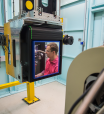
Call for Proposals
Proposals at the Australian Centre for Neutron Scattering and National Deuteration Facility.

Showing 141 - 160 of 982 results

Proposals at the Australian Centre for Neutron Scattering and National Deuteration Facility.

The High Performance Macromolecular Crystallography beamline will enable the study of very small (sub-5 micrometre) or weakly diffracting crystals, providing a state-of-the-art high-throughput facility for researchers. MX3 will be able to study the structures of large proteins and protein complexes for virology, drug design and industrial applications via goniometer mounted crystals, in-tray screening, or via serial crystallography methods.

Radioactive radon gas is a decay product of uranium and thorium, which are found naturally in rocks, soil and building materials. Radon is a significant component of background radiation and can accumulate in poorly ventilated indoor environments.
In this data set, we investigated the effect of charging a balloon, which was then hung in an enclosed space, on its level of radioactivity.
Students will write a hypothesis, graph data, write a conclusion and use provided information to answer questions about radioactivity and radon, experimental design, accuracy, validity and reliability.
ANSTO expertise provides much-needed information about groundwater resources in the Mozambique capital and district.

Dr Jian is involved in the study of accelerator optics and ion beam control, Ione beam interaction with different materials, IBA techniques and applications.


ANSTO is a recognised leader in radiation safety training, offering courses recognised by industry and relevant regulators.

Learn about isotopes using real examples and real data, including comprehensive isotopic data of the first twenty chemical elements in the periodic table (hydrogen to calcium). Teachers can use the accompanying worksheet, in sections or in its entirety, to develop student skills in literacy, numeracy, critical and creative thinking and ICT. These activities are suitable for students in Years 9 to 12.
Students will:
- learn how the number of neutrons and protons in an isotope affects its nuclear properties
- construct a section of the Table of isotopes, using MS Excel
- investigate the properties and uses of different isotopes

Recent catastrophic Australian bushfires produced extremely high levels of fine particle pollution.
ANSTO provides secondary students with a range of learning resources for those interested in science or studying for exams. For teachers, ANSTO provides learning resources and professional development, as well as in-school-term science tours and videoconferences. Workbooks are provided as required learning material to accompany a school visit to ANSTO. They can also be used on their own as a classroom resource.
Nuclear science and technology award recipients to deliver Distinguished Lectures at ANSTO.
ANSTO’s user office in Melbourne offers access to the Australian Synchrotron, a world-class research facility with over 4,000 user visits per year. ANSTO seeks collaboration and partnerships with research organisations, scientific users and commercial users.
Atomic structure of new cathode material for sodium ion batteries helps explain long life

ANSTO has a range of capabilities and expertise to support aerospace and space research.